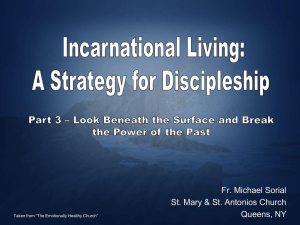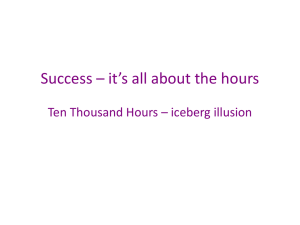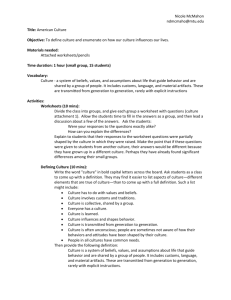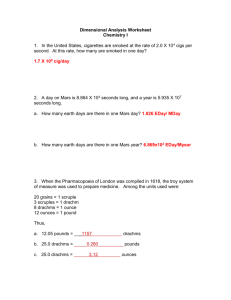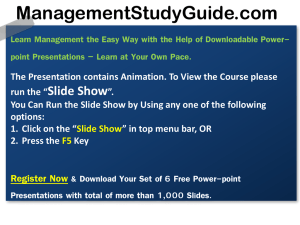A Practical Guide to Accelerating Student Achievement: Strategies
advertisement
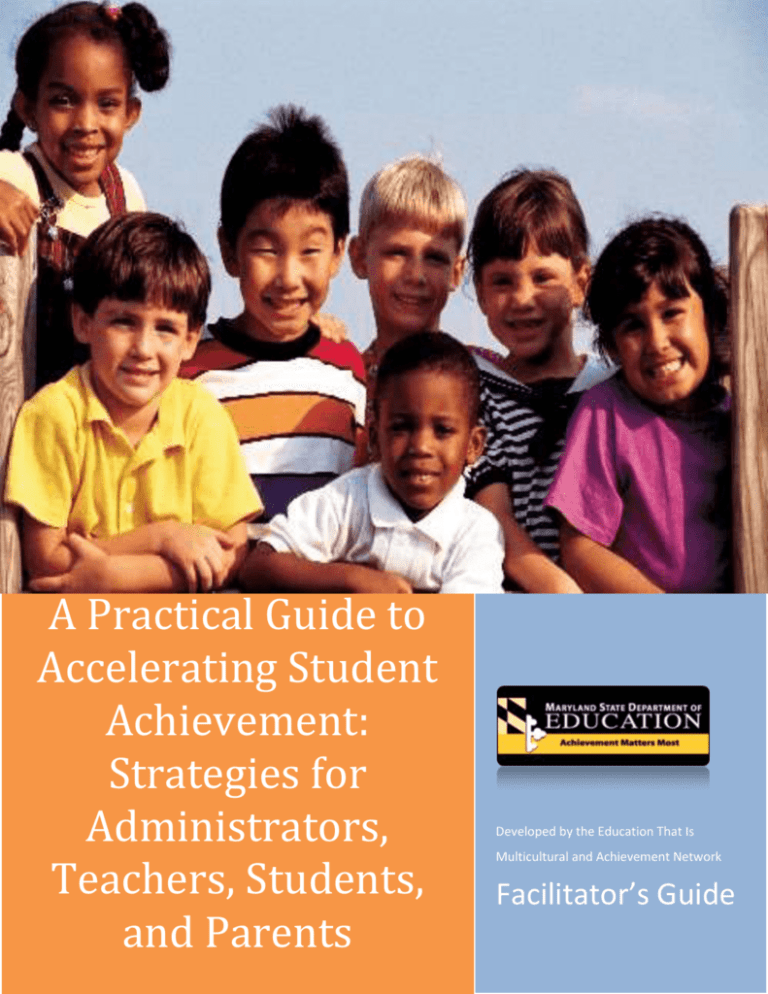
A Practical Guide to Accelerating Student Achievement: Strategies for Administrators, Teachers, Students, and Parents Developed by the Education That Is Multicultural and Achievement Network Facilitator’s Guide Introduction to the Practical Guide Outcomes: Examine the rationale for the Practical Guide. Identify and describe the five ETM Professional Development Competencies. Explore the Iceberg Concept of Culture. Agenda Time Guide Materials Introduction 5 minutes What is the Practical Guide? Goals of the Guide Getting Centered: Think and Share Exploring the Core Competencies 5 minutes A Practical Guide to Accelerating Student Achievement Across Cultures LCD Projector What is Culture? 10-15 minutes 5 minutes 10 minutes Laptop 15-20 minutes Final Word Protocol http://www.plcwashington.org/studygroups/protocols/learning-from-text/final-word.pdf 4 A’s Protocol http://www.nsrfharmony.org/protocol/doc/4_a_text.pdf Iceberg: Part 1 Iceberg: Part 2 10-15 minutes 10 minutes Key Points: 10-15 minutes A Tour of the Guide Closing 15 minutes 5 minutes Circle Thinking Map https://highlandlakes.dvusd.org/images/Thinking%20Maps.pdf Blank Iceberg Poster Completed Iceberg Concept of Culture http://www.doe.in.gov/lmmp/pdf/iceburgofculture.pdf Key Points: The Personal Cognitive and Social Dimensions of Culturally Responsive Teaching Worksheet Scavenger Hunt Worksheet Scavenger Hunt Answer Key The Last Word ~2~ Introduction (5 minutes) 1. Welcome all participants. Introduce yourself and team (if necessary). As a facilitator, you will guide the group through the activities to help them meet the professional development outcomes. 2. Make sure all participants have a copy of the guide before proceeding. 3. Ask participants to read the “Message from the State Superintendent,” on page ii. The Guide is designed to be selfselective for the user. The beginning administrator or a senior staff member may use it; the novice teacher or the master educator will find it equally valuable. Rationale for the Guide (5 minutes) 1. Review slide 3 with participants and refer them to practical guide pages 1 and 2. 2. Inform participants that the document is not intended to be an exhaustive source. Teachers who are grounded in the foundational knowledge bases for diversity are primed for facilitating achievement among marginalized student groups. ~3~ Goals of the Guide (5 minutes) 1. Review slide 4 with participants and refer them to guide page 3. Give them a few minutes to read, “Introduction to the Guide.” Becoming a culturally responsive instructor is a lifelong process. Getting Centered (10 minutes) 1. Have participants read the quote on slide 5 by Jennifer West, reflect on its meaning to them in their professional career, and then share their reflection with a partner. 2. Have participant volunteers share their thoughts with the whole group. Exploring the Core Competencies (15-20 minutes) 1. Divide participants into small groups, assigning one competency per group. For large staff, you will have multiple groups reviewing the same competency. 2. Each group will read the assigned competency. 3. Using the “Final Word” protocol, each person will respond to the competency. 4. After all ‘rounds,’ each person will summarize what they have learned about that competency. 5. Whole Group Discussion a. 1. What knowledge, skills, and dispositions do teachers need to have in order to meet the diverse learning needs of all of their students? b. 2. What knowledge and skills do teachers need in order to create safe, secure, and supportive learning environments for all students? 6. Record the “Big Points” or “Big Questions” that arise from the discussion. What is Culture? (10-15 minutes) 1. Select one of the following options to conduct with the participants. 2. Option 1: 4 A’s Protocol: Argue, Agree, Aspire, Assumptions (10 minutes) 3. Option 2: Circle Thinking Map a. Have participants place their name in the center of their circle map and place a cultural identifier in the surrounding, linking circles. For example, woman, Muslim, mother, Asian, immigrant, cancer survivor, etc. 4. Option 3: Define culture and identify cultural groups to which you belong. Select one of your cultural identities and give one example of how it impacts your life on a daily basis. 5. Debrief the exercise by allowing the participants to share their results. 6. Share the information on slide 7. Each bulleted item will rise with the click of the mouse. ~4~ Iceberg: Part 1 (10-15 minutes) 1. Distribute blank iceberg posters and ask participants to form a triad to complete the iceberg by writing those descriptors they believe belong in each section of the iceberg – surface, folk, deep – if participants are uncertain of what is meant by descriptors, the facilitator can give an example. (Slide 9) 2. Culture has been aptly compared to an iceberg. Just as an iceberg has a visible section above the waterline, and a larger, invisible section below the water line, so culture has some aspects that are observable and others that can only be suspected, imagined, or intuited. Also like an iceberg, that part of culture that is visible (observable behavior) is only a small part of a much bigger whole. 3. Tell participants that a random reporter will be chosen at the end to share with the whole group. 4. When time is up, triads post their icebergs on the walls. 5. At the end, choose a random reporter and ask that s/he share one descriptor for each section of their iceberg – the rule is to be additive not repetitive. 'Culture' is rather like an iceberg; you can see a little of it, in the same way that you can see how we behave 'on the surface.' But the biggest and most important part – our cultural values- are hidden below the surface. Values are all pervasive in our lives; vital to the way we operate in the world, yet largely unconscious and usually unarticulated. We acquire them at a very early age and they become part of our make-up, our cultural software. Geert Hofstede calls them the 'core of culture'. Unless we make a real effort to 'see them from the outside,' we don't know what they are, or what effect they have on people from different cultures. ~5~ Iceberg: Part 2 (10 minutes) 1. Distribute the completed iceberg. Explain surface culture, deep culture, and culture clash. 2. Culture clash is the misunderstandings, and disagreements between different cultures. Culture is learned. The clash is the unlearning and relearning of new cultures. 3. Debrief: Review slide 10. Surface Culture Food Holidays Arts Folklore History Personalities Deep Culture Ceremony Courtship and Marriage Esthetics Ethics Family Ties Health and Medicine Folk Myths Gestures and Kinesics Grooming and Presence Ownership Precedence Religion Space and Proxemics Concepts of Time Our values are always positive to us, and it's extremely difficult to see them as negative. For example, Dutch people generally take for granted that 'directness' is a good thing. If they think about it, they will usually ascribe to it positive values such as straightforwardness and honesty. This is fine, so long as the Dutch communicate amongst themselves. However, when Dutch and, for example, Japanese collaborators come together, something else is needed. For the Japanese, the positive cultural value is indirectness. Japan is a very high context culture, in which messages are covert and implicit, rather than overt and explicit. The result? Well, you could hit the cultural iceberg and sink. ~6~ Cultural Competence or Cultural Proficiency (10 minutes) 1. Slides 8-11 cover the tools of Cultural Competence. If this is an initiative of your district, please review the information with participants; otherwise, hide them prior to the presentation. 2. Slides 12-14 cover the continuum and essential elements of Cultural Proficiency. If this is an initiative of your district, please review the information with participants; otherwise, hide them prior to the presentation. Key Points: The Personal Cognitive and Social Dimensions of Culturally Responsive Teaching (10-15 minutes) 1. Option 1: Review the information on slides 17-22. 2. Option 2: Have participants complete the Key Points handout and discuss in a small group, each member taking at least one point and explaining it to the other members. A Tour of the Guide (15 minutes) 1. Distribute Scavenger Hunt handout. 2. Allow participants to work individually or in pairs to complete. 3. Use the answer key to review answers with the whole group. Closing (5 minutes) 1. Have a volunteer read the Glenn Singleton quote on slide 24. ~7~ SURFACE CULTURE FOLK CULTURE DEEP CULTURE ~8~ Key Points: The Personal Cognitive and Social Dimensions of Culturally Responsive Teaching Read each key point and write down what each point means to you in the second column. Read text pages 1-6 and make any necessary corrections to your thinking in the third column, What Does It Mean Now? Key Point Culture is a powerful yet often invisible factor that influences student learning. It’s important for teachers to understand the ways race, ethnicity, language and social class interact and may influence a student’s achievement. Schools have to be organized in such a way that the members of the community work collaboratively and create a caring environment for students. Many students do not enter school with the cognitive foundations in place to connect to the instructional strategies in the classroom. Students from various cultures and diverse backgrounds may have different experiences than those expected at school. Teachers must provide assistance for culturally and linguistically diverse students in order for them to access the curriculum and successfully achieve high standards. Schools have to be organized in such a way that the members of the community work collaboratively and create a caring environment for students. What Does It Mean to Me? ~9~ What Does It Mean Now? Key Point Many students do not enter school with the cognitive foundations in place to connect to the instructional strategies in the classroom. Educators must explore their own cultural experiences and identify how they impact the learning environment for students. Educators must model and articulate high expectations that result in high achievement for all students. Educators must demonstrate sensitivity to cultural bias in instructional materials and texts. Educators must demonstrate sensitivity to in classroom patterns of thinking, in modes of communication and in teaching/learning strategies. What Does It Mean to Me? ~ 10 ~ What Does It Mean Now? Practical Guide Scavenger Hunt (Answer Key) 1. The Practical Guide to Accelerating Student Achievement Across Cultures provides strategies for what advocacy groups of stakeholders? administrators, teachers, students, and parents (Cover) 2. According to the rationale for the guide, a culturally proficient workforce possesses the ability to and will to accomplish what five goals? Increase student achievement for all learning groups Ensure equitable access and support for participation in rigor instruction Prepare students academically and socially for life in a diverse society Strengthen student pride in their cultural identities Increase awareness and understanding of the commonalities and diversity among individuals and groups (Described on page 2 of the Rationale) 3. What are the five core cultural competencies that each advocacy group must develop? Intercultural communication Reducing prejudice Establishing culturally supportive learning environments Designing and implementing curriculum and instruction that is multicultural Designing tests, measurements, and assessments for achievement equity (Described on page 3 of the Introduction) 4. The Holistic Learner Framework is organized three dimensions of human development. What are they? Personal, cognitive, and social (page 5 Holistic Learner Framework) 5. What is the goal of Competency I, intercultural communication for all advocacy stakeholder groups? Adopt a global perspective that promotes the valuing of cultural, ethnic, and linguistic diversity. (Page 3, 9, 18, 27, 41) 6. How many strategies are there for reducing prejudice for administrators? (2 strategies, page 12 and 13 7. What two personal actions can administrators seeking to use tests, measurements, and assessments to access information and prepare for teaching and learning take? Use disaggregated achievement data to reflect on the effectiveness of the school in meeting the needs of all students Develop personal knowledge about a range of assessments (Described on pages 16 and 17) 8. How many personal, cognitive, and social actions are described in the Practical Guide for teachers seeking to establish culturally supportive learning environments? (Page 22 lists a total of 20 actions) ~ 11 ~ 9. What are the strategies for students concerned with establishing and maintaining high expectations for all students? Develop skills and competencies to enhance achievement Support a climate of commitment Actively seek support for your goals Develop knowledge and skills to become self-sufficient contributing member of a global society (Pages 34-37) 10. The professional development competencies for enhancing teacher efficacy in implementing instruction that accelerates student achievement are divided into two sets of key objectives. What are they? Education that is multicultural key objectives Minority achievement key objectives (Pages 58-63) Bonus Question: Based on your understanding of the Practical Guide, how would you describe the difference between the two sets of key objectives? Answers will vary. Some important points are: ETM objectives focus more on building personal capacity to live and work in a culturally diverse world Minority achievement objectives are focused on professional competencies to ensure elimination of disparities in student achievement by race and culture ~ 12 ~ Practical Guide Scavenger Hunt Question Page Found The Practical Guide to Accelerating Student Achievement Across Cultures provides strategies for what advocacy groups of stakeholders? According to the rationale for the guide, a culturally proficient workforce possesses the ability to and will to accomplish what five goals? What are the five core cultural competencies that each advocacy group must develop? The Holistic Learner Framework is organized three dimensions of human development. What are they? What is the goal of Competency I, Intercultural Communication for all advocacy stakeholder groups? How many strategies are there for reducing prejudice for administrators? What two personal actions can administrators seeking to use tests, measurements, and assessments to access information and prepare for teaching and learning take? ~ 13 ~ Answer How many personal, cognitive, and social actions are described in the Practical Guide for teachers seeking to establish culturally supportive learning environments? What are the strategies for students concerned with establishing and maintaining high expectations for all students? The professional development competencies for enhancing teacher efficacy in implementing instruction that accelerates student achievement are divided into two sets of key objectives. What are they? Bonus Question: Based on your understanding of the Practical Guide, how would you describe the difference between the two sets of key objectives? ~ 14 ~ References Susan, Arisman. Introduction to the Guide. Hanley, Jerome. (1999). Beyond the tip of the iceberg: Five stages toward cultural competence. Reaching today’s youth. Vol.3 No.2 pp. 9-12. National School Reform Faculty. Harmony Education Center PO Box 1787 Bloomington Indiana 47402 • 812.330.2702 nsrf@harmonyschool.org • fax 812.333.3435 Comments: webmaster@harmonyschool.org last modified: 04/19/2010 13:40:23 Robins, Kikanza Nuri, Lindsey, Randall B., Lindsey, Delores B., and Terrell, Raymond. (2006) Culturally Proficient Instruction: A Guide for People Who Teach. California. Corwin. Smith, Judith. Rationale for the Guide. West, Jennifer Moy. The Holistic Learner Framework: A Culturally Responsive Approach to Accelerating the Achievement of Low Performing Student. ~ 15 ~ Contributors Anne Arundel County Natalie Jones Carroll County Margaret Kulow Carroll County Patricia Levroney Cecil County James Zimmer Frederick County Ted Luck Frederick County Ava Maria Whittemore MSDE Woodrow B. Grant Jr. Washington County Joni Burkhart ~ 16 ~
